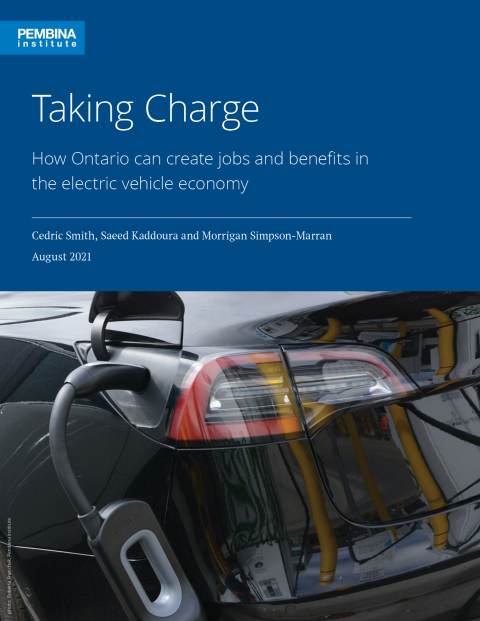As Canada transitions to a decarbonized economy, and with the federal government’s recently announced target that all new light-duty car and passenger-truck sales be zero-emission by 2035, Ontario must act swiftly to leverage the strength of its auto industry and pivot to much greater uptake of electric vehicles (EVs).
While investments have been made in Ontario’s EV supply chain and production capacity, those investments are insufficient. To realize the job creation and economic growth potential in Ontario and be economically competitive with the United States, Europe, and China, each of which have secured sizeable shares of the EV manufacturing supply chain over the past 10 years, financial instruments, policy changes and planning need to be coordinated and mobilized.
In this paper, we present the economic and job creation potential of accelerating electrification in Ontario’s light-duty vehicle market, from manufacturing to maintenance to the development and installation of charging infrastructure.
Like other jurisdictions where there is now strong support for a local EV market, Ontario is well positioned to capitalize on the economic growth potential in EV development and production — approximately 80% of electric vehicles are sold in the same region where they are manufactured. Moreover, forecasts indicate that, at the global level, automakers will invest some $300 billion in the EV sector over the next five to 10 years.
If Ontario expands the light-duty electric vehicle market to 100% of total new light-duty vehicle sales by 2035, the potential direct, indirect and induced economic benefits associated with EV manufacturing are substantial — estimated at more than 24,200 jobs and over $3.4 billion in gross domestic product (GDP) by 2035. The additional direct, indirect and induced economic and job benefits associated with investing in Ontario’s EV charging infrastructure are estimated to create 23,100 or more jobs and approximately $2.7 billion in GDP.
Recommendations
We recommend that the province take following actions:
- Establish an Ontario Transportation Electrification Council to set out a long-term, coordinated and holistic electrification strategy that involves ministries responsible for transportation, economic development, energy, natural resources, and environment as well as labour, training, and skills development.
- Build consumer awareness about the potential savings realized over the life time of owning an EV thereby addressing concerns about the higher purchase cost.
- Mobilize private capital in ZEV infrastructure by issuing a green bond to finance infrastructure for electric vehicles.
- Increase widespread availability of EV-charging infrastructure by amending the Ontario Building Code to require new residential buildings to be EV-ready.
- Fill gaps in public charging station availability to address range anxiety. This means investing in public charging stations, including Level 2 chargers, and DC fast chargers.
- Help Ontarians and businesses save on electric vehicle and private charging purchases by introducing a time-limited financial incentive program to reduce the difference in purchase price between EVs and comparable internal combustion engine vehicles and support the purchase of private EV chargers for homes, workplaces, and fleets. Priority should be given to increase EV accessibility to lower-income households and small- and medium-sized enterprises.
Through decisive and targeted action, Ontario can capitalize on the strengths of its automotive industry, and be a competitive player in a global automotive sector that is rapidly trending towards electrification.









